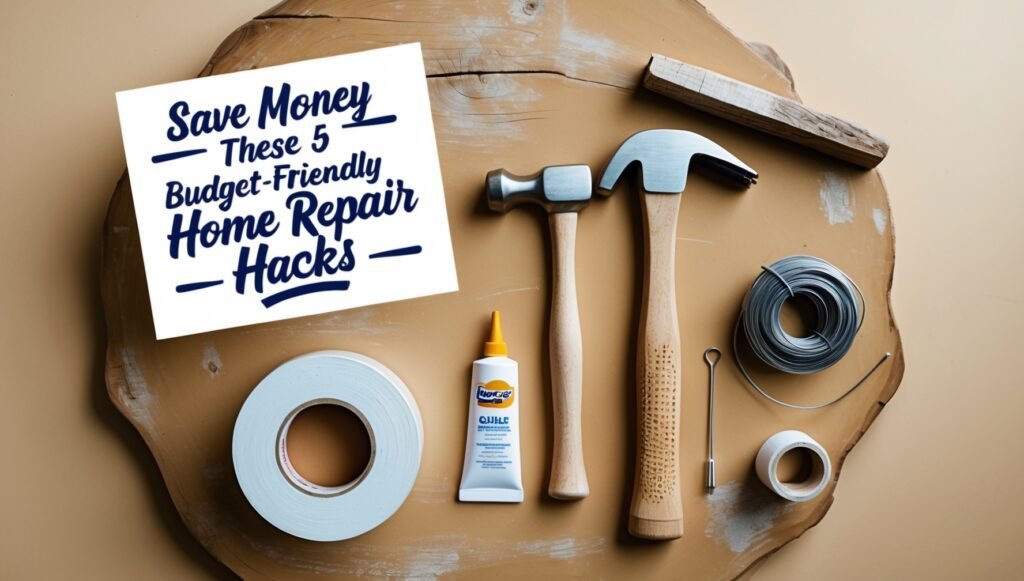
Home repairs can be daunting, especially when you look at the cost of hiring professionals or buying expensive materials. But the good news is that many common house repairs are doable without breaking the bank. With the right tools, a bit of patience, and a little creativity, you can tackle repairs and upgrades on your own and save money. In this post, we’ll share 5 budget-friendly home repair hacks that will help you keep your home in top shape without breaking the bank.
1. Fix a Squeaky Door with Lubricant or Petroleum Jelly
Problem: There’s nothing more annoying than a squeaky door that grates every time you open or close it. The squeak often comes from the hinges, which can be caused by dirt, dust, or the hinges being dry.
The Budget Fix: Rather than buying expensive lubricants, a simple solution is petroleum jelly. Here’s how to do it:
Step 1: Open the door wide so you have clear access to the hinges.
Step 2: Apply a small amount of petroleum jelly to the hinge pins. You can use a cloth to wipe it on evenly.
Step 3: Close and open the door several times to work the jelly into the mechanism. This should silence the squeak almost instantly.
Why It Works: Petroleum jelly is a great alternative to traditional lubricants. It is cheap, easy to find, and effective for minor door hinge repairs. It also prevents further wear by reducing friction on the hinge pins.

2. Use Baking Soda and Vinegar to Unclog Drains
Problem: A clogged drain is a common issue in most households, especially in the kitchen and bathroom. It’s often tempting to reach for harsh chemical cleaners, but these can be expensive and damaging to your pipes.
The Budget Fix: Instead, try using a simple, eco-friendly solution of baking soda and vinegar. This method works wonders for both slow drains and occasional clogs.
Step 1: Pour about 1/2 cup of baking soda into the clogged drain.
Step 2: Follow it with 1/2 cup of vinegar and quickly cover the drain with a cloth to keep the fizz inside.
Step 3: Let it sit for 15 minutes, then flush the drain with hot water.
Why It Works: Baking soda and vinegar create a chemical reaction that loosens debris in your pipes, making it easier for water to flow freely. Plus, both ingredients are non-toxic, inexpensive, and readily available.

3. Fix a Loose Tile with Construction Adhesive
Problem: Loose tiles, especially in the kitchen or bathroom, are an annoying issue. Instead of retiring the entire surface, which can be costly, you can fix a loose tile quickly with construction adhesive.
The Budget Fix:
Step 1: Remove the loose tile carefully and clean the back of the tile and the surface beneath it to ensure a solid bond.
Step 2: Apply a small amount of construction adhesive (available at most hardware stores) to the back of the tile.
Step 3: Press the tile firmly into place and allow the adhesive to cure for at least 24 hours before using the surface again.
Why It Works: Construction adhesive holds tiles in place, and it’s much cheaper than hiring a professional to retile your space. It also saves time and effort, making this an ideal quick fix for minor tile problems.

4. Refinish Wooden Furniture with a New Stain
Problem: Wooden furniture can look worn over time, with scratches, stains, or faded finishes. Rather than replacing the pieces, you can refinish them yourself with a fresh coat of stain or paint.
The Budget Fix:
Step 1: Clean the piece thoroughly, removing any dirt, grease, or grime.
Step 2: Lightly sand the surface to remove the old finish and to prepare the wood for staining or painting.
Step 3: Apply a new wood stain or paint in the color of your choice, following the product instructions. Let it dry, then add a protective finish to seal the surface.
Why It Works: Refinishing wooden furniture is a cost-effective way to restore old furniture to its former glory. It’s an easy DIY project, and a little stain or paint can make a huge difference in the appearance of your furniture.
For a full guide on restoring furniture, check out our DIY Furniture Restoration Guide.
5. Patch Small Hole In The Wall with Joint Compound
Problem: Small holes in the wall, whether from nails, screws, or accidents, are easy to overlook but can be unsightly if left untreated.
The Budget Fix: You don’t need to hire a handyman to patch holes in your walls. With a little joint compound and some basic tools, you can easily repair these imperfections.
Step 1: Clean the hole and remove any debris from around it.
Step 2: Use a joint compound or spackle to fill the hole. Apply it with a putty knife, smoothing it out so it’s level with the rest of the wall.
Step 3: Once the compound dries (usually in a few hours), sand it smooth, then paint over it to match the rest of the wall.
Why It Works: The joint compound is inexpensive and easy to use, making it a brilliant solution for small repairs. It also works well on drywall and plaster walls, leaving a clean finish once sanded and painted.
For more detailed instructions on home repairs, check out our DIY Home Repair Mastery e-book for more tips.
Home repairs don’t have to cost a fortune. By using some simple, budget-friendly hacks, you can fix common issues around your home and save money. From fixing squeaky doors to patching holes in the wall, these DIY fixes are easy to do and require minimal investment in tools and materials.
For more ways to improve your home and save money, don’t forget to check out our Save Big, Fix Small guide. This comprehensive e-book covers more ways to keep your home in top shape while sticking to your budget.
With these easy and affordable repair tips, you’ll be able to tackle any home improvement project with confidence, saving both time and money.
FixItSmartly.com helps everyday people save money and build confidence by tackling home and car repairs with easy, practical DIY solutions. Live smart, safe, and self-reliant — one fix at a time.
Copyright © 2025 Fixitsmartly